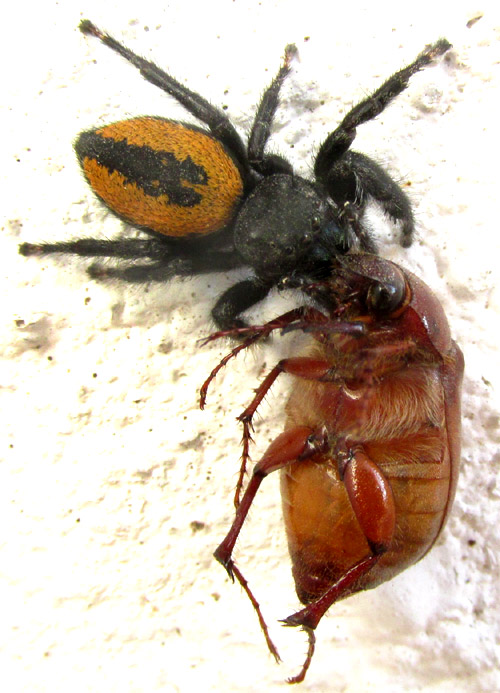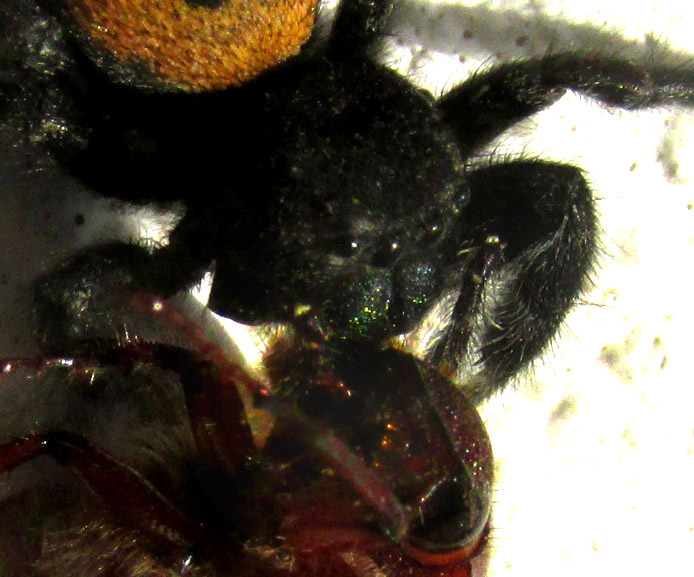Excerpts from Jim Conrad's
Naturalist Newsletter
entry dated June 4, 2023, issued from near Tequisquiapan, elevation about 1,900m (6200 ft), Querétaro state, MÉXICO
(~N20.55°, ~W99.89°)
DESERT RED JUMPING SPIDER

In the walled-in backyard of a small village surrounded by overgrazed scrubland and hacked-over mesquite thickets, the above was spotted on the vertical riser of a concrete step behind a house. Settling ground had caused the steps to pull away from the house's foundation, opening between the steps and the house a crack wide enough to stick a pencil into, so probably the spider lived there. In the picture, the prey is one of many species of junebug, genus Phyllophaga. But, who is the spider?

The spider's legs are so thick, hairy and black that it could be a small species of tarantula, or megalomorph. One difference between regular spiders and megalomorphs, however, is that megalomorph fangs point straight down, while those of regular spiders diagonally cross one another. Above, the fangs can't be seen, but it seems as if the spider is holding on to the junebug with a fang slanting in from the picture's left side, stabbing into the junebug's head. So, I focused on regular spiders, not megalomorphs.
In the above photo, the spider's "face" is flat and directed horizontally forward. Like most spiders, it possesses eight eyes, but this one has four exceptionally large, conspicuous ones in a line at the face's top. This arrangement is typical of jumping spiders, which comprise about 600 described genera in some 6000 species, in the Jumping Spider Family, the Salticidae. However, I'd never seen such a large jumping spider.
Checking out Internet pictures of Mexican jumping spiders, it didn't take long to find an image coming close to our spider's appearance, as seen on Wikipedia's Phidippus johnsoni page, the Red-backed Jumping Spider. That species is described as one of the largest and most commonly encountered jumping spiders in western North America. However, GBIF's Phidippus johnsoni occurrence map indicates that that species enters Mexico only in northern Baja California.
Still, it was apparent that our spider probably was a member of the genus Phidippus, currently regarded as embracing about 79 species. A feature of Phidippus is that its "jaws," or chelicerae, are iridescent green. The above picture was taken in deep shade so the iridescence isn't as bright as it could be, but there's still a hint of it.
In 2004, G.B. Edwards published an excellently illustrated "Revision of the Jumping Spiders of the Genus Phidippus (Araneae: Salticidae)," with distribution maps. Scanning color photos of all the species he treated, our spider with its horseshoe-shaped, orangish-yellow markings on its abdomen, and black front part, the cephalothorax, clearly matched the species he referred to as PHIDIPPUS ARDENS, sometimes known as the Desert Red Jumping Spider.
Edwards describes Phidippus ardens as inhabiting shrubs, mesquite, creosote and grasslands from 1500-8200 elevation (4900-26,900ft), so that fits fine, since we're surrounded by mesquite and ranchland. The GBIF's Phidippus ardens occurrence map shows the species generally present throughout much of the western US, with only five documented occurrences at this time in central Mexico, the closest observation to us being in San Luis Potosí state to our north. It seems that here we have expanded the species' known distribution a good bit south.
The most recent work on Phidippus I can find is the 2022 study by Luis C. Hernández Salgado and others entitled "New Distributional Records of Phidippus (Araneae: Salticidae) for Baja California and Mexico: An Integrative Approach." I sent our pictures with information including coordinates to the above study's team member assigned to deal with correspondence, Fadia Sara Ceccarelli, at a CONACYT research institution in Ensenada, Baja California, who very quickly replied.
She said that this was valuable and interesting information, and that in Mexico much work remains to be done defining Phidippus species. She added that she suspects that several species occur here that have not yet been named.
How about that? Something new right beneath a step I climb every day...